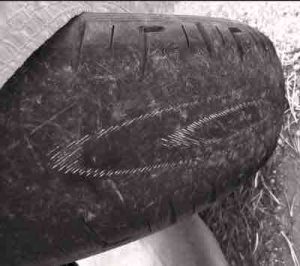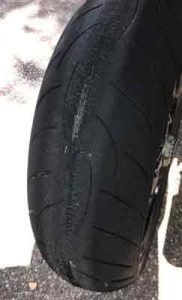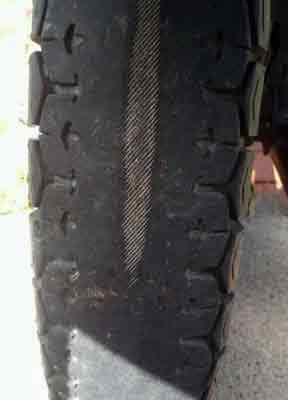The wires showing in your tire are a part of the structure of the tire that holds it erect.
The rubber that has vanished off the surface was the mold of tread on the tire that helps it grip pavement on the road when you drive.
We’d hate to see what happens to that tire if suddenly another bike pulls in front of you on the highway and you have to apply the brakes.
How long can you really drive on your bike tires with wires showing? There are varying opinions on how long you can drive a bike with the tires showing wires or cords. Some say you can still drive for 80 miles. Others say lesser. One thing is true though, no one knows.
The treads are gone from your tire, all you have are wires which do really badly when it comes to traction.
You might get away with 80 miles while you drive on your bike tires with wires showing, or you might not. You might get away with 100 miles, even.
We value your life so, our advice is: don’t drive with a tire showing wires. Change the tires.
Table of Contents
What makes tire wires show fast?

Everything in nature wears out eventually. Everything is man-made too. Tires are not left out.
Our tires are constantly kissing pavement, mercilessly being rubbed on by hard concrete.
And if you are an outdoor person who loves riding bikes for fun, your tires are sure to bear the brunt of such intense activities.
Over time, the tire on your bike would wear out, lose tread and you have replaced it with fresh ones.
But sometimes you’d notice a peculiar kind of wear where the wires begin to show on your tire faster than normal.
As we have said already, driving on this kind of wear is an extreme sport on its own.
The following are the reasons your tire shows wires really fast:
- Problem with alignment
- Overinflation of tires
- Underinflation of tires
Problem with alignment
If you have wires showing fast in your motorcycle tires it could be a problem with the alignment.
It may be the tire is bent just a fraction of a tilt. Even this minute misalignment is enough to cause a concentration of rubbing on a portion of the tire, wearing it to the wires.
You see this in the wires showing to either side of the tire, left or right.
Overinflation of tires
If you have the habit of overinflating your tires, it will begin to wear fast along the center until it begins to show wires.
This part of the tire will become thin as the rubber rubs off, it shallows out and before the moment it bursts you’ll see the wires showing.
When you overinflate your tire, it bulges in the center giving way to the phenomenon explained above.
What follows is a fast decline of the tire.
Under inflation of your tires
If your tire suffers often from underinflation, the edges of the tire will carry much of the load. Soon the tires begin to wear thin along the edges till the wires begin to show.
What you should do if the wire shows in your motorcycle tire?

The wires showing in the tire of your motorcycle is an indication that your tire has little time left among the living, (in the auto world) so to speak.
For all intent and purposes, that tire is dead. The tire’s fate is just about sealed. With every revolution it makes thereon out, it stands a chance of blowing out. This is critical to your safety.
The Tire Industry Association recommends that ‘tires that are worn to the tires tread wear indicators or 2/32 inch remaining tread depth in any area of the tread should not be repaired.’
Not all tires can be repaired, definitely not one that its wires are already showing through.
What you should do if wires are showing in your tire is scrap the tire and replace it with a new one, as soon as possible.
It has lost structural integrity.
Frequently Asked Questions (FAQ) on bike tires
Dry rot: How long does it take for a motorcycle tire?
Dry rotting or sidewall weathering refers to the situation where there is visible disintegration or cracking in the tire’s sidewall or tread.
This happens when the compounds that the tire is made of break down.
Your motorcycle tires can start to dry rot from five years after you start to use them.
However, the acceleration of dry rotting depends on the weather conditions of your location. The process is slower in humid environments while it is faster in arid ones.
You can prevent your tire from dry rotting by avoiding prolonged exposure to sunlight.
Sometimes, take your bike out for a ride, doing this helps the tires to stay fresh longer instead of covering it up in your garage.
Keep the tires off the ground by keeping your bike parked on a motorcycle stand. Once again, if you live in a very humid region, there isn’t much good for your tires by keeping them covered all the time.
How long can you ride on a bald tire?
Don’t ride on a bald tire. Absolutely don’t. A bald tire has lost all its tread.
The purpose of the tread is, one, to create traction with the road. Without it, you risk your life.
Two, the tread helps disperse water on a wet road while driving in the rain. A bald tire simply slides across the surface of the water.
You’ll go straight ahead at a bend because the tire has lost the ability to grip the road.
You also run the risk of running into the back of vehicles ahead of you because the tires won’t brake efficiently.
Truth is, many users dread buying new tires for motorcycles. Taking money out of the wallet to invest in new tires can be a major drag, so you see a few of these bald tires on the road.
Postponing the purchase of a new tire means you’d continue to ride on the bald one. In reality, you only put off something that would save your life.
How much tread is safe on a motorcycle tire?
1/32 inches to 2/32 inches of tread, that’s how much.
Continuous use depletes treads on tires on your motorcycle. Since the middle of the tire experiences the most contact with the road, this is where you measure your tread depth.
If your motorcycle tires has wear indicator cast into the tread grooves, then take a look right now to make sure your treads are still safe to drive with.
You will have to change your tire once you hit the mark. Sadly, many motorcycle users are unaware of these tread safety measures.
One easy way to get a reading on your tire tread is by using the coin test. Two different coins can be used, the quarter and the penny.
Insert the coin so that the top of the president’s head is pointing inward, into the bottom of the groove on your tire.
If you see all the president’s head when you use the quarter, it means you have 4/32 inches of tread.
If with the penny you see all of Lincoln’s head it means your tire still enjoys a 2/32 inches tread depth. This hack is for when a tread gauge is unavailable.
When should a motorcycle tire be replaced?
Do you know your motorcycle tires aren’t expected to last as long as car tires?
And for good reason. Motorcycle tires are softer, more malleable, and softer than car tires.
Motorcycles are smaller than cars so if their tires are any bigger than they are, you can imagine how much it would affect their speed and stability.
That said, your motorcycle tire’s lifespan is around five years.
You should replace your motorcycle tires if:
- If the tread depth is below 2/32 inches
- If the tire has dry rot
- Is the tire more than 5 years old?
- If your tire is punctured in the sidewall
- If the wires are showing
- If the tire has cracks
Although it is recommended that after five years you should begin to contemplate a replacement for your tire, still, it is difficult to predict the lifespan of a tire.
So many factors affect how a tire either ages quickly or slowly. Things like the weather conditions of your environment, how you store the tire, the load it carries, the kind of stress the user puts it through.
All this influences how fast your tire ages. Your tire may be less than five years old and be looking like ten. Or vice versa.
Definitely replace your tire if the wires are showing through. Your tire is far gone when this happens. It means your tire has combined most of the signs outlined above and is worn out.
Oxidation causes cracks in tires, you can see this around the sidewall, or in spaces between traction blocks. This is a sign that you should replace the tire.
Is driving on bald tires illegal?
Yes, it is illegal to drive with bald tires. Laws on this vary from state to state, however.
Most states in the US have varying laws that regulate the requirements for motorcycle and car tires, some are hard and fast, others aren’t so particular and state officers would let it slide.
Some states policemen would stop you to check the tread depth of your tire, though.
In some states too, police would not be so concerned about your bald tires except it is the cause of an accident like when the road is wet and your tires hydroplaned thereby causing a crash.
Some policemen may stop you to issue you a ticket mandating you to replace your bald tire within 30 days, after which you are required to check into a police station to have the order signed off by an officer.
If you are in doubt about the details of these laws in your state you should check with the police department nearest to you.
Can you get fined for bald tires?
Yes, you can. The authorities are always doing their best to make the roads as safe as possible for road users.
This is why there are laws that guide the condition of tires that are acceptable for road use.
If you drive without enough tread depth in your tires, or if your tire is totally bald you can get booked.
This happened to a woman in Laporte, Indiana. She had been driving with bald tires when her car slid across the snow and rammed a truck causing injury for her and those in the car with her.
The police booked her up to $500. This story appeared in the South Bend Tribune.
Fine for driving on bald tires vary from state to state. In Queensland, the penalties for driving with a bald tire can be stiff. And it can increase from one year to the other.
It can range from $110 for a first offender to $220 for three bald tires. In California, law enforcement officers can cite drivers with bald tires on the premise that it is a safety hazard.
However, the prerogative of whether it is a fine payable in money or just a correctible ticket lies with each specific officer.
That officer would have to consider the extent of the defect in the tire and make his decision. California vehicle code section 27465 is clear about tread depth for tire safety in the state.
To avoid paying these fines, include checking your tires regularly on your to-do list.
There are legal tires and there are illegal ones. A tire with its wires showing is an illegal tire and should not be used. So is a bald tire.
Both are hazardous to you and other road users.

